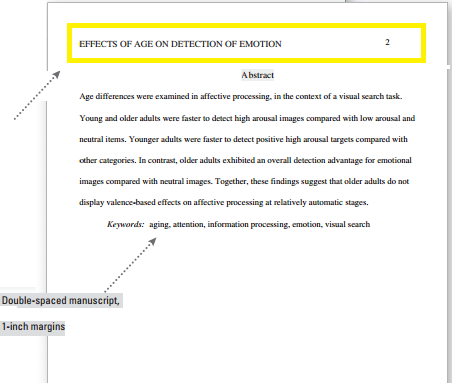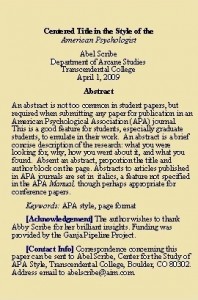It’s an information-laden world, there’s no doubt. Thank heavens someone invented abstracts!
An abstract saves you from having to read or skim through pages and pages of an academic paper. Soon you learn what the writer has done, what they’ve thought, what and how they’ve studied, and what they’ve concluded. Simple, eh? Not every student faced with writing an abstract would agree.
Some guides recommend writing the abstract last. That might be the last thing on a weary writer’s mind after writing the paper itself. But if you can’t write the abstract with some ease, you may need to revisit the thought process you used in writing the paper. In other words, after developing your study, doing the research and drawing the conclusions, you should be able to summarize what has happened in 200 words or less. But “should” is not always easy. Here are some hints, tips, and formatting how-to’s.
What’s in an abstract?
The abstract has four parts: 1. Question: What research question did you ask? 2. Methodology: How did you explore your question? 3. Results: What did you find out? 4. Discussion: What might be the significance of your findings? Don’t write anything in your 200 words that isn’t in the paper itself. Edit ruthlessly. Include a sentence or two exploring the possible implications of your conclusions. Indicate any future research that could or should be done. (Write about those more completely in the discussion section of your paper.)
How do I say it?
To write the abstract, imagine writing home about what you’ve been up to – that is, if your siblings, parents, friends, etc. are interested in what you’ve been thinking (on a scholarly level, that is)! 1. Take a deep breath. 2. Re-read your paper; then put it aside so you don’t just copy from it. 3. Ask yourself, “What’s my research all about?” 4. Have compassion for your weary, information-flooded reader. 5. What did you wonder about? What did you discover? Why does it matter? Explain. In 200 words. Or less. Do that, and you truly grasp your paper as a whole. You may have even learned something creating it.
How do I format an abstract?
Writing an abstract poses two challenges:
1. You have to figure out what to say. Fortunately that’s probably the harder part.
2. You have to follow the formatting dictated by your professor or the publication (it could happen) that may publish your work. Often this is the American Psychological Association’s style (APA), and we’re now into the 6th edition of same. Rejoice! Sources for APA style information abound on the web. Of course, you might be someone who cannot abide the tedium of “underline?…comma, period, semicolon…?” In that case, let the editors at In Writing come to your aid. We thrive on that. Bibliographies and footnotes? Get ready to tear out your hair style-wise.
Abstract style: a quick guide
 First, the Abstract page is always page 2. Include a “running head” on it (a condensed, 50 character or less version of the title on the left, the page number on the right). Next, center the word “Abstract” (minus the quote marks!) just below. Then, type your abstract in one paragraph, block style (no indents).
First, the Abstract page is always page 2. Include a “running head” on it (a condensed, 50 character or less version of the title on the left, the page number on the right). Next, center the word “Abstract” (minus the quote marks!) just below. Then, type your abstract in one paragraph, block style (no indents).
What about keywords?
You may want to include a keywords section. This isn’t required by APA style per se, but it might be required by your professor. And it seems like a good skill to practice. Select your keywords thoughtfully; they’re an even more condensed version of your paper.
How to format a keywords section per APA style:
Make a paragraph just below the abstract. Indent it. Type the word Keywords, in italics, followed by a colon, then type your keywords separated by commas. Don’t capitalize the first word after the colon (unless it would be capitalized anyway). There’s no period at the end of the list. Your abstract and the keywords section – should take only half a page. Leave the rest blank. Start your paper at the top of page 3.
Don’ts when writing abstracts
1. Don’t define terminology or phrases; do that in the body of your paper. (Clearly if your paper is ABOUT varying definitions, that rule isn’t relevant).
2. Don’t cite or quote outside sources. The abstract is about YOUR thought and research. (An obvious exception would be if a particular bit of existing research forms the basis for your paper’s investigation.)
3. Don’t use future tense, like “this paper will show.” Use present tense and past tense.
4. Don’t use “I,” “we,” “my,” “our,” etc. Stick to third person (he, she, it, they, etc.)
5. Try, as in most good writing, to avoid what’s called “passive voice.” You can recognize passive voice if the sentence leads to the question “by whom?” For instance – “It was determined that…” invites you to ask, “By whom?” A better sentence answers that question right away, that is, it’s what’s called “active voice.” The above in active voice: “These findings suggest….”
Do’s
A final “do” would be this: Think carefully about what you’ve accomplished. Envision a world full of people who want or need to read your conclusions. Then give yourself 200 words, give or take, to tell them what they can learn from your work!<


